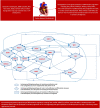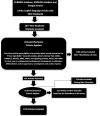The benign nature and rare occurrence of cardiac myxoma as a possible consequence of the limited cardiac proliferative/ regenerative potential: a systematic review
- PMID: 38110859
- PMCID: PMC10726542
- DOI: 10.1186/s12885-023-11723-3
The benign nature and rare occurrence of cardiac myxoma as a possible consequence of the limited cardiac proliferative/ regenerative potential: a systematic review
Abstract
Background: Cardiac Myxoma is a primary tumor of heart. Its origins, rarity of the occurrence of primary cardiac tumors and how it may be related to limited cardiac regenerative potential, are not yet entirely known. This study investigates the key cardiac genes/ transcription factors (TFs) and signaling pathways to understand these important questions.
Methods: Databases including PubMed, MEDLINE, and Google Scholar were searched for published articles without any date restrictions, involving cardiac myxoma, cardiac genes/TFs/signaling pathways and their roles in cardiogenesis, proliferation, differentiation, key interactions and tumorigenesis, with focus on cardiomyocytes.
Results: The cardiac genetic landscape is governed by a very tight control between proliferation and differentiation-related genes/TFs/pathways. Cardiac myxoma originates possibly as a consequence of dysregulations in the gene expression of differentiation regulators including Tbx5, GATA4, HAND1/2, MYOCD, HOPX, BMPs. Such dysregulations switch the expression of cardiomyocytes into progenitor-like state in cardiac myxoma development by dysregulating Isl1, Baf60 complex, Wnt, FGF, Notch, Mef2c and others. The Nkx2-5 and MSX2 contribute predominantly to both proliferation and differentiation of Cardiac Progenitor Cells (CPCs), may possibly serve roles based on the microenvironment and the direction of cell circuitry in cardiac tumorigenesis. The Nkx2-5 in cardiac myxoma may serve to limit progression of tumorigenesis as it has massive control over the proliferation of CPCs. The cardiac cell type-specific genetic programming plays governing role in controlling the tumorigenesis and regenerative potential.
Conclusion: The cardiomyocytes have very limited proliferative and regenerative potential. They survive for long periods of time and tightly maintain the gene expression of differentiation genes such as Tbx5, GATA4 that interact with tumor suppressors (TS) and exert TS like effect. The total effect such gene expression exerts is responsible for the rare occurrence and benign nature of primary cardiac tumors. This prevents the progression of tumorigenesis. But this also limits the regenerative and proliferative potential of cardiomyocytes. Cardiac Myxoma develops as a consequence of dysregulations in these key genes which revert the cells towards progenitor-like state, hallmark of CM. The CM development in carney complex also signifies the role of TS in cardiac cells.
Keywords: Cardiac myxoma; Cardiac progenitor cells; Cardiac regeneration; Cardiogenesis; Cardiomyocytes; Stem cells; Tumor suppressors; Tumorigenesis.
© 2023. The Author(s).
Conflict of interest statement
The authors declare no competing interests.
Figures
Similar articles
-
Functional cardiomyocytes derived from Isl1 cardiac progenitors via Bmp4 stimulation.PLoS One. 2014 Dec 18;9(12):e110752. doi: 10.1371/journal.pone.0110752. eCollection 2014. PLoS One. 2014. PMID: 25522363 Free PMC article.
-
Transcription factor-induced activation of cardiac gene expression in human c-kit+ cardiac progenitor cells.PLoS One. 2017 Mar 29;12(3):e0174242. doi: 10.1371/journal.pone.0174242. eCollection 2017. PLoS One. 2017. PMID: 28355297 Free PMC article.
-
Cardiomyogenic differentiation in cardiac myxoma expressing lineage-specific transcription factors.Am J Pathol. 2002 Aug;161(2):381-9. doi: 10.1016/S0002-9440(10)64193-4. Am J Pathol. 2002. PMID: 12163362 Free PMC article.
-
Microenvironment in Cardiac Tumor Development: What Lies Beyond the Event Horizon?Adv Exp Med Biol. 2020;1226:51-56. doi: 10.1007/978-3-030-36214-0_4. Adv Exp Med Biol. 2020. PMID: 32030675 Review.
-
The mysterious pathways of cardiac myxomas: a review of histogenesis, pathogenesis and pathology.Histopathology. 2015 Feb;66(3):321-32. doi: 10.1111/his.12531. Epub 2014 Nov 4. Histopathology. 2015. PMID: 25297937 Review.
Cited by
-
Circulating-tumour DNA methylation of HAND1 gene: a promising biomarker in early detection of colorectal cancer.BMC Med Genomics. 2024 Apr 30;17(1):117. doi: 10.1186/s12920-024-01893-9. BMC Med Genomics. 2024. PMID: 38689296 Free PMC article.
References
Publication types
MeSH terms
Substances
LinkOut - more resources
Full Text Sources



